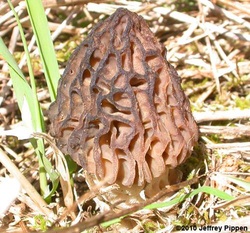- Home
- Mushrooms - why?
- Chaga mushroom - medicinal
- Red reishi - medicinal
- Chicken mushroom – food
- Puffballs - food
- Maitake mushroom - medicinal
- Chanterelle mushroom - food
- Lobster mushrooms - food
- Honey mushrooms -food
- Shiitake mushroom – medicinal and food
- Morels - food
- Oyster Mushrooms - medicinal and food
- Common poisonous mushrooms in NC
- How to grow oyster mushrooms at home
- Blog
Morel Mushrooms

Described by Mother Earth News as the No. 1 target of wild mushroom hunters across North America because of their earthy, nutty, steak-like flavor, morels are easy to identify from poisonous mushrooms with a similar appearance. Both morels and dangerous "false morels" have solid trunks
with a spongy, mottled, conical cap.
However, true morels are hollow inside their caps, so cutting a morel in half is the surest way to tell the safe morel from a poisonous morel. The other reason these are good basic mushrooms to hunt is that the consequences of making a mistake are not likely to be fatal if you cook the mushrooms thoroughly.
The morel season is spring to early summer, and you'll find them in damp forests and along river banks, especially in areas with sandy soil.
Fresh Morels are available in spring time.
Morels, Morchella esculenta, belonging to the genus Morchella, are not actually considered mushrooms in the true sense of the mushroom taxonomy classification. They are the fruiting body of a soil habitating fungus. Truffles share this same trait with Morels. Morels and truffles are from an entirely different class
known as Ascomycetes.
Morels are an easily identified fungus. Hollow from stem to crown, they have wrippled honeycomb-shaped spores throughout their fruiting body. Their color ranges from a muted grey to dark brown depending on species and simply, age. Morels impart a superior meaty and earthy flavor with a smoky and woodsy aroma not achieved with other mushrooms.
Morel mushrooms can never be eaten raw, though they need not be overly cooked to truly showcase their flavor. A simple saute with butter, salt and pepper is the best way to experience the rich flavors and aromas of the Morel. Prepare with cream or wine sauces, serve with pastas or a side dish to meats. Mature Morels require a longer cooking due to their chewiness. A spring season "mushroom", Morels pair
especially well with fresh English peas, asparagus and herbs such as chives,
tarragon and parsley.
with a spongy, mottled, conical cap.
However, true morels are hollow inside their caps, so cutting a morel in half is the surest way to tell the safe morel from a poisonous morel. The other reason these are good basic mushrooms to hunt is that the consequences of making a mistake are not likely to be fatal if you cook the mushrooms thoroughly.
The morel season is spring to early summer, and you'll find them in damp forests and along river banks, especially in areas with sandy soil.
Fresh Morels are available in spring time.
Morels, Morchella esculenta, belonging to the genus Morchella, are not actually considered mushrooms in the true sense of the mushroom taxonomy classification. They are the fruiting body of a soil habitating fungus. Truffles share this same trait with Morels. Morels and truffles are from an entirely different class
known as Ascomycetes.
Morels are an easily identified fungus. Hollow from stem to crown, they have wrippled honeycomb-shaped spores throughout their fruiting body. Their color ranges from a muted grey to dark brown depending on species and simply, age. Morels impart a superior meaty and earthy flavor with a smoky and woodsy aroma not achieved with other mushrooms.
Morel mushrooms can never be eaten raw, though they need not be overly cooked to truly showcase their flavor. A simple saute with butter, salt and pepper is the best way to experience the rich flavors and aromas of the Morel. Prepare with cream or wine sauces, serve with pastas or a side dish to meats. Mature Morels require a longer cooking due to their chewiness. A spring season "mushroom", Morels pair
especially well with fresh English peas, asparagus and herbs such as chives,
tarragon and parsley.
